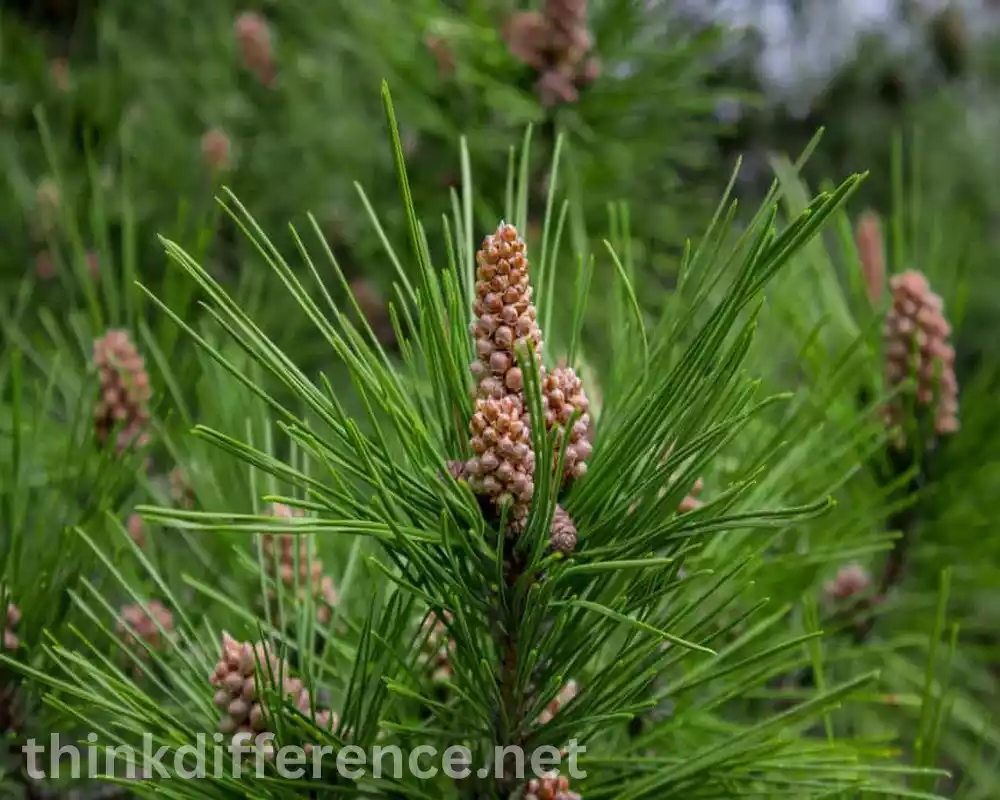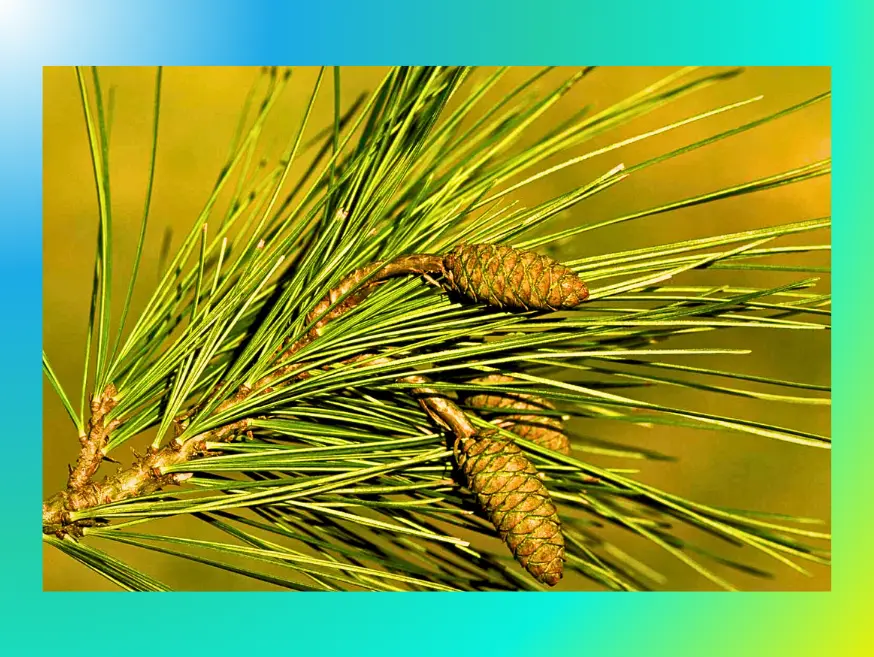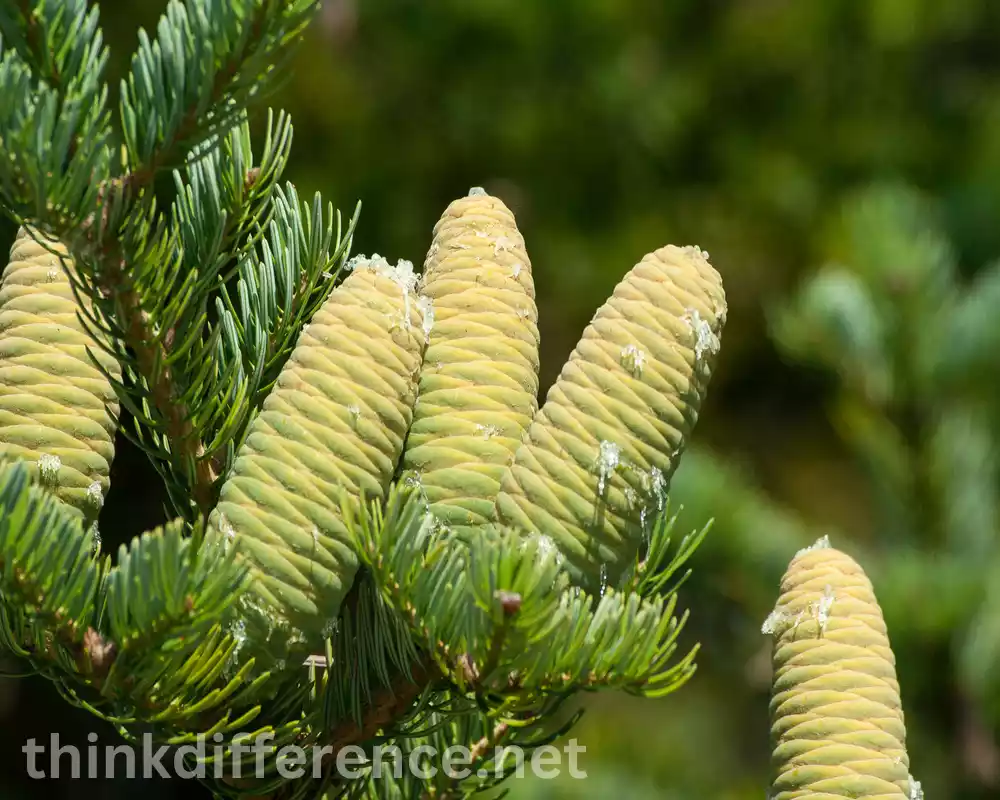Pine and Fir are two popular types of trees that are often used in various industries, including construction, furniture making, and paper production. Although they appear similar, their differences are clear. We will delve into the characteristics, uses, and unique features of both Pine and Fir trees, highlighting their significance and helping you understand their individual strengths.
What is Pine?
Pine trees belong to the Pinus genus of evergreen conifers that cover much of North America and Europe, providing shade in all seasons of year. Pine trees are known for their distinctive needle-like leaves, which are arranged in clusters or bundles. These trees typically have a conical or cylindrical shape and produce cones as their reproductive structures.

Pines are valued for their economic and ecological importance. They are widely utilized for timber production due to their strong and durable wood. Pine wood is commonly used in construction, furniture making, and the manufacturing of paper and pulp. Pine trees provide abundant resin that is utilized for various products like varnishes and adhesives.
Pine trees come in numerous varieties, each boasting its own individual characteristics and distribution area. Examples of pine species are Scots Pine (Pinus Sylvestris), Eastern White Pine (Pinus Strobus), and Ponderosa Pine (Pinus Ponderosa). All three of these pine varieties play an essential part in forest ecosystems by providing wildlife shelter, soil stabilization and nutrients cycling benefits.
Pine trees are recognized for their distinct appearance, adaptability to different climates, and versatile uses, making them a prominent and recognizable feature in many landscapes worldwide.
Characteristics of Pine
Pine trees stand apart from their counterparts by virtue of several distinguishing features.
Here are some key characteristics of pine:
- Needle-like Leaves: Pine trees have long, needle-shaped leaves that are typically arranged in clusters or bundles. These needles are typically dark green and remain on the tree throughout the year, as pines are evergreen.
- Conical or Cylindrical Shape: Pine trees often take on an upright and straight trunk that gradually taper toward their top, giving the impression of being cylindrical or conical in form. This shape allows them to shed snow easily in colder climates.
- Cones: Pines produce cones as their reproductive structures. Size and shape may differ depending on species. Pine cones typically consist of woody scales that protect and house the seeds.
- Bark: The bark of pine trees tends to be thick, rough, and furrowed. Bark can range in color from gray to tawny-brownish-red.
- Resin Canals: Pines have resin canals within their wood, bark, and needles. These canals produce resin, a sticky substance that acts as a defense mechanism against pests and pathogens.
- Adaptability: Pine trees are known for their adaptability to various climates and soil conditions. They can thrive in diverse environments, including dry, sandy soils and mountainous regions.
- Ecological Importance: Pine trees play an essential role in maintaining environmental sustainability as they provide food and habitat to many wildlife species such as birds and squirrels. Their dense foliage also helps in soil erosion prevention and provides shade to understory plants.
- Economic Significance: Pines are economically significant trees. Their strong and durable wood is widely used in construction, furniture making, and the production of paper and pulp. Pine resin is also harvested for various commercial applications.
There are various species of pine. Each variety displays some common traits. Their appearance and other distinctive qualities may vary considerably from each other.
Uses of Pine
Pine trees have a wide range of uses due to their strong and versatile wood, as well as other valuable products they yield.
Here are some of the key uses of pine:
- Timber and Construction: Pine wood is highly valued for its strength, durability, and workability. Construction uses it for multiple uses, including framing, roofing, siding and interior finishing. The straight grain and resistance to warping make it a preferred choice for structural purposes.
- Furniture and Cabinetry: Pine wood is frequently used in furniture making and cabinetry. Its light color and natural grain pattern lend themselves well to a rustic or country-style aesthetic. Pine furniture can range from simple, utilitarian designs to more intricate and decorative pieces.
- Paper and Pulp Production: Pine trees are a major source of wood fiber for the paper and pulp industry. The long fibers of pine wood make it suitable for producing high-quality papers, including printing and writing papers, tissue papers, and cardboard.
- Resin and Turpentine: Pine trees produce resin, a sticky substance that protects them against pests and pathogens. Resin is harvested from pine trees, and it can be processed to extract various products, including turpentine, rosin, and pitch. Turpentine is used as a solvent in paints, varnishes, and thinners, while rosin finds applications in adhesives, sealants, and musical instrument strings.
- Landscaping and Ornamental Trees: Certain pine species, such as the Eastern white pine and Scots pine, are widely planted as ornamental trees in parks, gardens, and landscapes. Their distinctive shape, evergreen foliage, and tolerance to various climatic conditions make them popular choices for providing shade and visual interest.
- Christmas Trees: As Christmas trees, certain species of pine such as Douglas Fir and Norway Spruce can be seen. Their attractive shape, pleasant aroma, and ability to retain needles make them desirable choices for holiday decorations.
- Essential Oils: Pine needles and twigs can be refined for essential oils that can be used in aromatherapy, perfumery and personal care products. Pine essential oil is known for its refreshing and invigorating scent.
- Erosion Control and Land Rehabilitation: Pine trees are often planted in reforestation efforts to control soil erosion and rehabilitate degraded lands. Their extensive root systems help stabilize soil, prevent erosion, and improve water retention.
These are just a few examples of the many uses of pine trees. The versatility of pine wood and the various products derived from pine make it a valuable and widely utilized resource in numerous industries.
Types of Pine Trees

Pine trees can be found across the world, each species boasting its own set of distinctive traits and distribution patterns.
Here are a few common types:
- Scots Pine (Pinus sylvestris): Scots Pine trees are popular trees throughout Europe, Asia and Northern Africa due to their long needles with orange-brown hues that stand out against their brown bark. It is one of the most widely distributed pine species and is valued for its timber.
- Eastern White Pine (Pinus strobus): Native to eastern North America, the Eastern white pine is a large, fast-growing tree with soft, flexible blue-green needles. It has a straight trunk and can reach impressive heights. It is often used in construction and as a landscaping tree.
- Ponderosa Pine (Pinus ponderosa): Found in western North America, the ponderosa pine is a tall tree with reddish-brown bark that develops black furrows with age. It has long needles bundled in groups of three. Ponderosa pine wood is highly valued for its strength and is used in construction, furniture making, and cabinetry.
- Lodgepole Pine (Pinus contorta): Native to western North America, the lodgepole pine is a slender tree with twisted branches and small, yellow-green needles. It is adapted to fire-prone areas and has serotinous cones that require heat to release their seeds.
- Monterey Pine (Pinus radiata): Native to coastal California and Mexico, the Monterey pine is a fast-growing tree with a pyramidal shape and long, dark green needles. It is extensively planted for timber production and is also used as an ornamental tree.
- Mexican Pinyon (Pinus cembroides): Mexican pinyon trees are small to medium pines with short, twisted twigs. Additionally, these pines produce edible pinenuts which play an integral part in both culture and ecology of their surroundings.
- Slash Pine (Pinus elliottii): Native to the southeastern United States, the slash pine is a large tree with long, dark green needles. It is often found in wetland areas and is used for timber, pulp, and reforestation purposes.
- Japanese Black Pine (Pinus thunbergii): Native to coastal regions of Japan and Korea, the Japanese black pine is a distinctive tree with rugged, blackish-brown bark and twisted needles. This tree can be utilized both as an ornamental feature and bonsai subject.
Below is just a small sampling of the many species of pine tree found worldwide, each species possessing distinct traits, abilities to adapt to differing climates and uses.
What is Fir?
Fir refers to a group of evergreen coniferous trees belonging to the genus Abies. Firs can be found across much of the Northern Hemisphere – North America, Europe and Asia all include this tree species as part of their range. Firs are known for their flat needle-like leaves, which are singular and attached directly to the branches.

Unlike some other evergreen trees, fir trees have erect or drooping cones, and these cones are an important characteristic used to differentiate them from pine trees. Fir cones typically disintegrate on the tree, releasing their seeds to the wind, rather than opening to disperse seeds like pine cones.
Firs are valued for their attractive appearance, and many species are used as ornamental trees in gardens and landscapes. They often have a conical or spire-like shape and can grow to be quite tall.
Douglas Fir is one of the best-known species, but it should not be mistaken as being true firs. True firs belong to Abies Genus; some examples being: Balsam Fir (Abies balsamea), Fraser Fir (Abies fraseri), Noble Fir (Abies procera), European Silver Fir (Abies alba) among many more species belonging therein.
Fir trees are important ecologically as they provide habitat for various wildlife and contribute to forest ecosystems’ stability and health. They are also used for their wood, which is used in construction, furniture making, and as Christmas trees due to their attractive appearance and pleasant aroma. Additionally, certain fir species are utilized in the production of essential oils for aromatherapy and other purposes.
Characteristics of Fir
Fir trees possess distinct characteristics that set them apart from other tree species.
Here are some key characteristics of fir trees:
- Flat Needle-like Leaves: Firs have flat needle-like leaves that are attached directly to the branches. These leaves are generally soft and flexible, with a flattened appearance. Unlike pine trees, firs have singular needles rather than needles arranged in clusters or bundles.
- Conical or Spire-like Shape: Firs typically exhibit a conical or spire-like shape, with a straight, symmetrical trunk that tapers towards the top. This shape gives firs an elegant and stately appearance.
- Erect or Drooping Cones: Firs produce cones as their reproductive structures. The cones of firs are typically erect or drooping, hanging down from the branches. Fir cones disintegrate on the tree to release their seeds, unlike pine cones that often open to disperse their seeds.
- Bark: The bark of fir trees is generally smooth, thin, and grayish in color, with shallow furrows or resin blisters. The texture and appearance of the bark may vary depending on the specific species.
- Softwood: Fir wood is classified as softwood, which means it is relatively less dense than hardwoods. It is lighter and easier to work with compared to many hardwood species.
- Aromatic Resin: Like other coniferous trees, firs produce resin. The resin acts as a protective substance against pests and pathogens. It also contributes to the pleasant aroma often associated with fir trees.
- Adaptability: Firs are adaptable trees and can be found in a variety of habitats, including mountainous regions, temperate forests, and even some subalpine and boreal environments. Different species of fir have different preferences for soil conditions and climate.
- Ornamental Value: Many fir species are valued for their ornamental value and are commonly planted in gardens, parks, and landscapes. The symmetrical shape, attractive foliage, and overall aesthetic appeal of firs make them popular choices for ornamental tree plantings.
It is important to note that while fir trees share certain common characteristics, there can be variations in appearance, needle length, cone shape, and other specific traits among different species of firs.
Uses of Fir
Fir trees have several practical uses due to their strong and versatile wood, as well as their aesthetic qualities.
Here are some common uses of fir:
- Timber and Construction: Fir wood is highly valued for its strength, durability, and straight grain. Construction uses lumber extensively for various uses, from framing and beams, to joists. The dimensional stability and workability of fir wood make it suitable for structural purposes.
- Furniture and Cabinetry: Fir wood is used in furniture making and cabinetry. Its light color, straight grain, and smooth texture lend themselves well to both rustic and contemporary furniture designs. Fir furniture can range from simple, utilitarian pieces to finely crafted cabinets and tables.
- Doors, Windows, and Millwork: Fir wood is often used in the production of doors, windows, and millwork. Its stability and resistance to warping make it suitable for these applications. Fir trim and molding are also popular choices for adding architectural details to interior spaces.
- Plywood and Veneer: Fir wood is commonly used in the production of plywood and veneer. The uniform grain and strength of fir make it suitable for these engineered wood products. Fir plywood is used in various construction and woodworking applications.
- Musical Instruments: Fir wood is used in the construction of musical instruments, particularly acoustic guitars and pianos. The resonant properties of fir wood contribute to the instrument’s tone and sound quality.
- Paper and Pulp Production: Some fir species, such as the balsam fir, are used in the paper and pulp industry. The long fibers of fir wood are desirable for producing high-quality papers, including printing papers, tissue papers, and specialty papers.
- Christmas Trees and Decorations: Certain fir species, such as the Fraser fir and Noble fir, are popular choices for Christmas trees due to their attractive shape, dense foliage, and pleasant fragrance. Fir branches and cones are also used in wreaths, garlands, and other holiday decorations.
- Essential Oils: The needles and twigs of fir trees can be distilled to extract essential oils. Fir essential oil is used in aromatherapy, fragrance production, and personal care products due to its refreshing and uplifting scent.
- Landscaping and Ornamental Trees: Many fir species are planted as ornamental trees in parks, gardens, and landscapes for their aesthetic value. They provide year-round greenery, add vertical interest, and create a pleasing backdrop in various settings.
It’s important to note that different species of fir may have specific uses or qualities that make them more suitable for certain applications. Additionally, some uses may vary regionally based on availability and local preferences.
Types of Fir Trees
There are several species of Fir trees found across different regions of the Northern Hemisphere.
Here are some common types of fir trees:
- Balsam Fir (Abies balsamea): Native to North America, the balsam fir is a medium-sized tree with dense, dark green foliage. It is a popular choice for Christmas trees due to its symmetrical shape and pleasant fragrance.
- Fraser Fir (Abies fraseri): Found in the Appalachian Mountains of the southeastern United States, the Fraser fir is a narrow, pyramid-shaped tree with dense branches and blue-green needles. It is also a favored Christmas tree species.
- Noble Fir (Abies procera): Native to the western United States and Canada, the noble fir is a tall tree with a conical shape and dense, bluish-green foliage. It is widely used as a Christmas tree and is known for its strong branches that can hold heavy ornaments.
- Silver Fir (Abies alba): Commonly found in central and southern Europe, the silver fir is a large tree with a broad, pyramidal crown and dark green needles with a silvery underside. It is valued for its timber and is also planted as an ornamental tree.
- Grand Fir (Abies grandis): Native to western North America, the grand fir is a tall tree with a narrow crown and glossy, dark green needles. It is known for its citrus-like scent and is used as a Christmas tree and for lumber.
- Subalpine Fir (Abies lasiocarpa): Found in the mountainous regions of western North America, the subalpine fir is a medium-sized tree with short, blue-green needles and a narrow crown. It is adapted to high elevations and colder climates.
- Korean Fir (Abies koreana): Native to South Korea, the Korean fir is a small to medium-sized tree with dark green needles that have silvery-white undersides. It is planted as an ornamental tree for its attractive foliage and compact shape.
- Siberian Fir (Abies sibirica): Native to Siberia and northern Asia, the Siberian fir is a medium-sized tree with dark green needles and a conical crown. It is valued for its timber and is also planted as an ornamental tree.
Here is just a glimpse into some of the many species of Fir trees found worldwide, each species offering distinctive qualities in terms of characteristics, adaptability to climate change and purpose.
Comparison table of Pine and Fir
Below is a comparison table of the key characteristics of Pine and Fir trees:
| Characteristic | Pine Trees | Fir Trees |
|---|---|---|
| Needle Shape | Long, needle-like leaves bundled in clusters | Flat, needle-like leaves individually attached |
| Needle Cluster | Grouped in clusters (2 to 5 needles per fascicle) | Needles grow individually from the branch |
| Cone Shape | Ovoid or cylindrical cones | Cylindrical or elongated cones |
| Bark Texture | Thick, rough, and often resinous | Smoother and thinner, less resinous |
| Strength | Strong and stiff | Strong and harder than pine |
| Durability | Moderately durable, some species are more decay-resistant | Moderately to highly durable, resistant to decay |
| Resin Content | High resin content, often sticky | Lower resin content, less sticky |
| Wood Texture | Coarse texture | Fine texture |
| Grain Pattern | Straight or slightly wavy grain | Straight and uniform grain pattern |
| Common Uses | Construction, furniture, interior finishing, paper production | Construction, exterior siding, doors, musical instruments |
| Examples of Species | White Pine, Red Pine, Yellow Pine | Douglas Fir, Balsam Fir, Noble Fir |
Similarities Between Pine and Fir
Pine and fir trees, despite their differences, also share some similarities due to their classification as coniferous trees within the Pinaceae family.
Here are some common similarities between Pine and Fir trees:
- Evergreen Nature: Both pine and fir trees are evergreen, meaning they retain their foliage throughout the year. They do not shed all their needles or leaves during a particular season, unlike deciduous trees.
- Coniferous Characteristics: Both pine and fir trees are classified as conifers, which means they bear cones as their reproductive structures. The cones of both trees contain seeds and play a crucial role in their reproductive cycle.
- Needle-shaped Leaves: While the appearance of the needles differs, both pine and fir trees have needle-shaped leaves rather than broad leaves found in deciduous trees. Pine needles are typically long and bundled in clusters, while fir needles are flat and attached individually.
- Resin Production: Pine and fir trees produce resin, a sticky substance that acts as a protective agent against pests, pathogens, and environmental stresses. Resin also contributes to the distinct aroma often associated with both tree types.
- Drought Tolerance: Both pine and fir trees are generally adapted to withstand periods of drought and have mechanisms to conserve water. They have needle-shaped leaves, reduced surface area, and often possess deep root systems that allow them to access water from deeper soil layers.
- Ecological Importance: Pine and fir trees are ecologically significant and provide habitat for various wildlife species. They contribute to forest ecosystems, providing shelter, food, and nesting sites for animals, as well as helping to stabilize soil and maintain watershed health.
- Economic and Commercial Value: Both pine and fir trees have economic importance. They are harvested for their wood, which is used in construction, furniture making, and the production of paper and pulp. They are also cultivated as Christmas trees and ornamental trees for landscaping purposes.
While pine and fir trees have distinctive features and characteristics, they share common traits that align with their classification as conifers. These similarities contribute to their significance in various ecological, economic, and cultural contexts.
Wood Texture and Grain
Wood texture and grain are important characteristics that can vary between different tree species, including pine and fir.
Here’s a comparison of the wood texture and grain of pine and fir trees:
Pine Wood:
- Texture: Pine wood typically has a relatively coarse texture. It can feel somewhat rough to the touch due to the presence of large open pores on the wood surface.
- Grain: Pine wood exhibits a straight or slightly wavy grain pattern. The grain is generally more pronounced and visible, which contributes to the distinctive appearance of pine lumber.
- Color: Pine wood can vary in color, ranging from pale yellow to reddish-brown. Some pine species, such as the popular Southern Yellow Pine, may have a pronounced yellow hue. The color tends to darken with age and exposure to light.
Fir Wood:
- Texture: Fir wood has a finer and smoother texture compared to pine wood. It typically has a relatively even and consistent surface that feels smoother to the touch.
- Grain: Fir wood often features a straight and uniform grain pattern, with a fine texture. The grain lines are generally less pronounced compared to pine, giving fir wood a more subtle and uniform appearance.
- Color: Fir wood ranges in color from pale yellow to light reddish-brown. The color can be relatively light and uniform, with minimal color variation between growth rings.
It’s important to note that the texture and grain of wood can also vary within species, depending on factors such as the growing conditions, age of the tree, and specific wood sample. Different species of pine and fir may exhibit variations in texture, grain, and color. These descriptions provide a general overview of the typical characteristics associated with pine and fir wood.
Strength and Durability
When it comes to strength and durability, pine and fir wood have some differences due to variations in their density and structural properties. Here’s a comparison of the strength and durability of Pine and Fir wood:
Pine Wood:
- Strength: Pine wood is known for its strength and stiffness. It has good load-bearing capabilities and can withstand moderate to heavy weights. Pine wood is relatively soft compared to other hardwoods and thus more vulnerable to scratching or denting than hardier alternatives.
- Durability: Pine wood is classified as a softwood, and its natural durability can vary depending on the specific species. While some pine species, such as the longleaf pine, have higher natural resistance to decay and insects, most pine wood is considered moderately durable. It is suitable for indoor applications and can be treated or coated to enhance its resistance to decay and insect damage when used outdoors.
Fir Wood:
- Strength: Fir wood is generally stronger and harder than pine wood. It has good structural integrity and is capable of withstanding higher stress and heavier loads. Fir wood has an exceptional strength-to-weight ratio, making it suitable for many construction applications.
- Durability: Fir wood is considered moderately to highly durable, depending on the species. It is naturally resistant to decay and rot, making it suitable for outdoor applications without the need for additional treatments. Fir wood is known for its ability to withstand weathering and has been historically used in exterior construction, including siding, decking, and trim.
Strength and durability may depend upon factors like growth conditions, wood processing procedures and treatments applied during processing. Specific species within the pine and fir families may have variations in their strength and durability properties. Proper maintenance, finishing, and protection from moisture and environmental factors are essential to ensure the long-term durability of both pine and fir wood products.
Applications in Industries
Both pine and fir trees have various applications in different industries due to their unique characteristics and qualities. Here are some common applications of pine and fir in industries:
Pine:
- Construction: Pine wood has become increasingly popular as an economical, strong and abundant material in construction applications due to its affordability, strength, availability and aesthetic properties. Pine is often chosen over other materials due to its strength, affordability and availability which make it the go-to material choice.
- Furniture and Cabinetry: Pine wood is utilized in furniture making, including tables, chairs, cabinets, and shelves. It can be stained or painted to achieve different finishes and styles.
- Interior Finishing: Pine wood is used for trim work, baseboards, moldings, and paneling, adding warmth and character to interior spaces.
- Packaging and Pallets: Pine lumber is commonly used in packaging applications, such as crates, boxes, and pallets, due to its strength and affordability.
- Paper and Pulp: Pine trees are a significant source of wood fiber for the paper and pulp industry. Wood waste is transformed into pulp for use in making various paper products such as writing paper, newsprint and cardboard boxes.
- Biomass and Bioenergy: Pine wood residues and byproducts can be used as biomass fuel or converted into bioenergy, contributing to renewable energy production.
Fir:
- Construction and Timber: Fir wood is valued for its strength, stability, and workability, making it suitable for construction purposes, including framing, beams, and flooring. It is also used in timber production for building materials and structural applications.
- Exterior Siding and Decking: Fir wood, particularly Western red cedar (a type of fir), is favored for exterior siding, decking, and cladding due to its natural resistance to decay and insects. It provides durability and aesthetic appeal to outdoor structures.
- Doors and Windows: Fir wood is utilized in the manufacturing of doors, windows, and window frames, thanks to its stability, resistance to warping, and ease of machining.
- Furniture and Joinery: Fir wood is used in the production of furniture, cabinets, and joinery. It can be finished with stains or clear coats to showcase its natural beauty.
- Musical Instruments: Certain fir species, such as Sitka spruce, are highly sought after for soundboards in musical instruments like guitars, violins, and pianos, due to their excellent acoustic properties.
- Decorative and Craft Products: Fir wood is employed in the creation of decorative items, carvings, and craft projects due to its workability and aesthetic appeal.
These applications demonstrate the versatility and utility of both pine and fir in various industries, providing a wide range of products that serve different needs.
Conclusion
Pine and fir trees are valuable members of the evergreen family, offering numerous benefits to the environment and human society. Understanding their unique characteristics, uses, and significance in ecosystems is crucial for their preservation and sustainable utilization.



